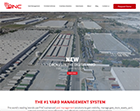Web Cite City
Yard Management

4SIGHT
4SIGHT Connect was born by leveraging more than 60 years of loading dock equipment experience and innovation to create a suite of connected products designed to help facilities optimize their yard, loading dock and warehouse logistics. 4SIGHT Connect is streamlining the entire loading and unloading cycle, resulting in faster turn times and higher operational efficiency, placing our customers in a position to excel in the supply chain of the future.

C3 Solutions
www.c3solutions.com/live-demo-request/
C3 Solutions is an information technology company specialized in yard management (YMS) and dock scheduling (DSS) systems. Since its founding in 2000, C3 has gained the confidence of clients around the world and across many industries including retail, grocery, distribution, manufacturing and parcel post. Headquartered in Montreal (QC), Canada and privately owned, C3 is dedicated to developing, implementing and supporting the most complete yard management and dock scheduling products on the market today. For more information on C3’s products, schedule a free online demonstration.

Exotrac
Exotrac’s Yard Management System is affordable software providing real time visibility and optimizing efficiency while minimizing detention costs. Exotrac’s solutions cover a broad spectrum of industries such as: Manufacturing, Retail, Food, Chemical and Automotive Distribution as well as 3PL, Truck and Trailer Leasing and Automotive Manufacturing. Seamless integration and alerts keep you connected to your yard operations 24/7. Keep your yard moving, keep your business moving, and get a quick ROI with Exotrac.

InSync Software
InSync’s Yard Manager answers the age old question: "Where’s my stuff?" Yard Manager utilizes active and passive RFID and GPS technologies to provide a complete real-time inventory view across storage yard networks. Operators can log into the system via a browser-based Internet portal to manage asset in/out processes and search multiple locations for specific inventory. Customers in construction, utility, fleet management, and other industries utilize InSync’s Yard Manager to rapidly locate and track assets, reduce waste and shrinkage, and improve project efficiencies.

PINC Solutions
Yard Hound® from PINC Solutions is the answer to your least-talked-about bottleneck in the logistics system: the yard. Increasing yard operations efficiency may be the next great opportunity to improve your logistical performance. With real-time visibility of all your yard activities accessible through a Web-based platform, managing yard operations becomes an integral part of your supply chain management practice. No longer is there a missing link between the warehouse and transportation logistics.

Sentier Systems Inc. (Yard Commander)
Yard management software shouldn’t be complicated or expensive. Yard Commander is a Web-based YMS that’s simply effective. We’ve made the software fully functional while avoiding unnecessary “features.” At the same time we’ve kept it intuitive and user friendly. Yard Commander offers the most affordable and easy-to-use YMS on the market.

SFI Dedicated Logistics
http://www.southernfreight.com
SFI Dedicated Logistics is the specialist in yard optimization, providing a complete outsourced third-party solution to optimize any yard operations. SFI’s unique yard solution includes recruiting, hiring and onsite management of drivers, trailer switching and hostling, supplying the most modern yard hostling tractors, and full insurance and flexibility to adapt to and address even the most complex issues arising out of yard operations. And, SFI enables carriers to get in and out of your facility quickly. The more driver-friendly your facility, the better the service you’ll get from your carriers. For more details, visit the web site.

Turbo Sales & Leasing
http://www.turboterminaltractors.com/
Turbo leases one of the nation’s largest inventories of terminal tractors—including top brands like TICO, Ottawa, and Capacity—for large fleets based at warehouses, distribution centers, and ports. The No. 1 priority behind Turbo’s leasing program is to maintain minimal downtime and maximum uptime for the 24/7 operations of its customers. Terminal tractor leasing programs are customized to each customer’s specific needs and budget requirements because Turbo understands that one size (or lease) does not fit all.

Yard Management Solutions
www.yardmanagementsoftware.com
Eagle Eye by Yard Management Solutions is your ultimate partner as it works 24/7 to increase efficiencies, streamline operations and reduce costs. Real-time visibility and instant analytics on all assets, shipments and workforce activities deliver the moment-to-moment pulse on your operation. Powerful functions lighten your workload and do the heavy lifting for you and our alert system will notify your team of problems before they arise. Our cloud based software is easy to learn, simple to use and will keep your team informed, on track and in motion. Call 800-766-6197.

YardView Yard Management Software
YardView Yard Management Software o ers an extensive suite of YMS tools that help the most challenging operations get a handle on their gates, docks, and yards. Appointment & Dock Scheduling, Gate Check-in/Check-out systems, Digital Twin Yard Mapping of every location and point in your operation, Analytics, Metrics, Reporting, Dashboards, and KPIs that help your team with every task, automation of your tasks and integration with any system. YardView is the leader in full-suite operations software systems.
